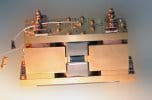Physicists in France are the first to watch single photons appear spontaneously, live a brief life, and then vanish into thin air. The experiment is the best realization so far of "quantum non-demolition" (QND) measurements on single photons, whereby the presence of a photon is determined without destroying it. As well as providing an elegant demonstration of quantum mechanics, the researchers also believe that the technique could be exploited in quantum information systems (Nature 446 297).

Detecting a photon usually involves absorbing the photon – and ultimately destroying it – in a photodetector. However, it is sometimes possible to make a measurement in a much gentler manner, leaving the system in more or less the same state as was measured. Such QND measurements have become commonplace for large systems like atoms – which can be probed gently using photons. But photons are much more delicate than atoms, which makes QND very difficult.
Now, Michel Brune and colleagues at the Ecole Normal Supériore in Paris have turned the table and used atoms to make a QND measurement of the quantum state of a system containing one photon. Brune’s system is a microwave cavity that has been cooled to 0.8K. At this temperature, there is about a 5% chance that the cavity will be devoid of microwave photons and a 50% chance that the cavity will contain just one photon (that has spontaneously appeared from the vacuum, only to vanish less than one second later).
The presence of a photon is detected by passing a stream of rubidium atoms though the cavity. These are so-called Rydberg atoms, which have an electron in a highly excited state and are very sensitive to external perturbations, such as electric fields. The atoms are prepared such that they can exist in one of two quantum states (“g” and “e”). If the atoms cross an empty microwave cavity, most of them will emerge in state g, whereas if they encounter a photon the majority will emerge in state e.
The atoms are flipped between g and e by a non-resonant interaction with the cavity field. The photon cannot be absorbed without violating energy conservation, and instead it leaves its “imprint” on the atom by displacing the position of the atomic energy levels. A high resolution spectroscopy method is used to determine the state of the atoms as they emerge from the cavity. In this way, Brune and colleagues were able to make hundreds of such measurements on a single photon without destroying it.
By measuring the state of the emerging atoms, Brune and colleagues were able to watch as a single photon emerged from the vacuum, lived a brief life of less than one second, and then vanished. While this phenomenon was predicted nearly one hundred years ago, this is the first time that it has been observed directly.
Brune told Physics Web that the researchers now plan to repeat the experiment with tens of photons in the cavity. This should provide insight into the so-called “semi-classical” regime between the quantum description of light as single particles and the classical view of light as a continuous electromagnetic wave.
Beyond demonstrating the fundamentals of quantum mechanics, Brune believes that the technique could be used in quantum information systems, which try to exploit the bizarre nature of quantum systems to process information. For example, the cavity can be thought of as a logic gate that switches the quantum state of the atoms according to the presence of a single photon.



